At the height of the art-deco movement, Southern Railways lead the UK in the move from steam trains to electric, and naturally needed some control rooms to manage the electricity supply. So they built a bunker just outside Woking, which remained in use until 1997 before being finally decommissioned.
Had you been in Woking last weekend, you could have taken a look inside.
Built in 1936 by the Swedish firm of Asean, it is built of concrete with flat roof and metal-framed casement windows. Even from the outside, this is a fairly impressive brick and concrete building, and was built to withstand a bomb-blast at a time when war with Germany was starting to look increasingly likely.
Although built right to the railway, access for pedestrians is down a short alley on a residential street, and past a barking dog in the neighbouring house.
A corridor passes several offices, including one which was originally the inbound telephone exchange to the entrance block and within is a narrow corridor that runs around the edge of the building, while the inner sanctum is lined from the outside by walls of electro-mechanical switch gear.
As alluring this sight is, it is the inner room that sits within the concrete block that is the art-deco secret within. The Control Room is oval with domed ceiling and has four ornate 1930’s lamps on cast-iron columnar bases with copper dishes which illuminate the dome as uplighters – and the huge light bulbs within them.
Around the outside of the room are the track diagrams arranged in a striking design of silver against black background with coloured lights to represent all the switches.
On this annual open day, small groups were taken around and given a very detailed explanation of how everything worked. Details which I am scared to recount lest the train-geeks scream in outrage if I get the slightest thing wrong 😉
Suffice to say that it needed two people to run the facility, and the job included monitoring the live network as well as ensuring that engineering works could be carried out safely. The inner control room originally had air ducts around the top of the curved ceiling, but these contained asbestos so were sealed decades ago. The room is therefore freezing in winter, and boiling hot in summer as the concrete walls suck up the heat.
Each of the display boards contained the name of the location or junction being controlled, with lights indicating various states of operation. The old-style filament bulbs all glow slightly even when “off” so that the operators can be sure the bulbs haven’t blown and need replacing. There is a distinctive hum in the room when it is working – which was very noticeable when they cut the power for a moment to show the difference.
However, it is behind the control boards that will delight any electrical enthusiast as the electro-mechanical nature of this very early control room becomes apparent. I was pleased to ensure I photographed the Woking box, as it seemed appropriate.
Dotted around the place are a few memories of its last days, including the 1997 calendar from when it closed, and mobile phone numbers with dialing codes from the very earliest days of mobile phones in the UK.
A memento of very old days which will probably confuse younger visitors was this old-school pencil sharpener. The telephone exchange at the main desk still needed to have the connections made manually and the handle wound to generate power for the phone.
This was one of five original control rooms built by this firm for Southern Railways of which only three survive – Woking being the last to remain operational. It is now listed and preserved as it was left, although parts of the building are used for storage and an archive of old documents and scraps of electrical equipment.
The control room is open to the public just once a year on the Heritage Open Days events. Put it in your diary for next September, it’s worth the visit.
There are more photos over here.

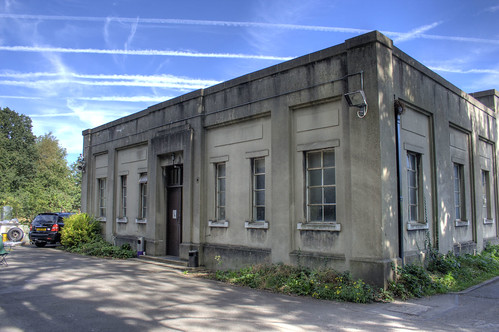

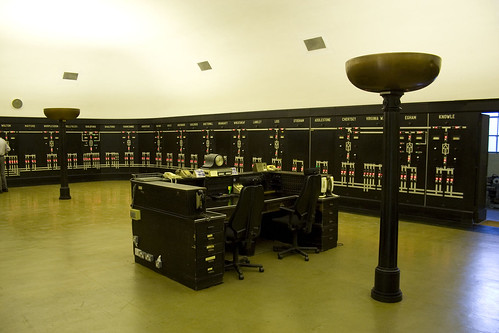
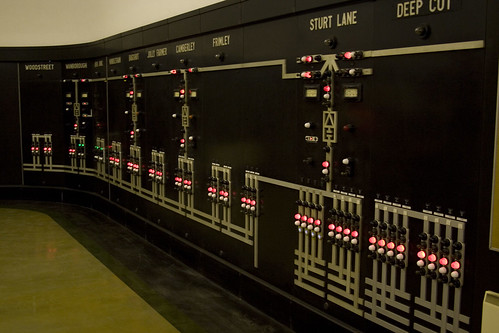
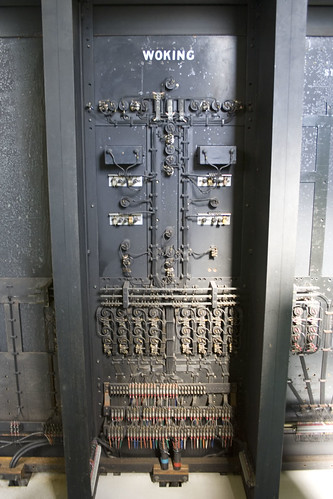
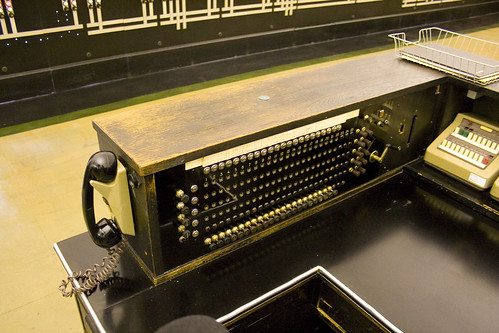







Beautiful! I doubt I’ll ever get to Woking at appointed time, so seeing these pics is great.
What a stunning piece of industrial design.
I love Art Deco – it looks so – substantial!
It’s just a shame nothing built nowadays looks as impressive.
Beautiful!
I’m 99,9999% sure that the swedish firm is ASEA (Allmänna Svenska Elektriska Aktiebolaget, roughly translates to general swedish electrical company) without an N. Ca 20-25 years ago Asea and Brown Boveri joined up to todays ABB.
ASEA used the swastika as their logo until the german nazis started to use the swastika.
ASEA produced a lot of electrical rail wehicles, including locomotives, EMU’s, underground trains and trams. I think that part is now a part of Bombardier, or was it Adtranz?
The story of how ASEA started to manufacture power semiconductors is intersting. In the 50’s they bought a couple of semiconductor diodes from GE (IIRC) to try them on electrical locomotives. The diodes didn’t work very well, and ASEA got fed up with the problems and started to produce their own power semiconductor diodes and later all kinds of power semiconductors. 🙂
@MiaM
Adtranz was ASEA Daimler-Benz Transportation. Adtranz was then bought out 100% by Daimler but then later sold to Bombardier.
The swastika was commonly used as a symbol for power (and many other things) until it then became a political symbol under the Nazis. My Swedish Dad tells me that old maps in Sweden used the swastika as a symbol for power stations.
True.
ASEA supplied the equipment, and control structure.
The Swastika is on some of the cubicles, relays, and the old diagrams.
The author was slightly confused about a bunker, true the WWII Traffic Control Bunker was 1Km away London side of the station.
Ex-ECRO J.P.
Nice to know you’re still keen on the old place John! I wonder how the visitors react to the acoustics in the old bathtub? Of course, we remember how hot it got inside the control room…even with the ventilation running flat out and the side roller door shutter open! Havant ECR was looking very sad when I last saw it. I’m pleased Woking ECR has survived. I’m looking for photos of Three Bridges and Ore ECRs by the way. our old colleagues Len Grier worked at Ore ECR of course. Best wishes Rob Mannion G3XFD (I think your old callsign was G8JMW wasn’t it?)
Thankyou for writing this. I live right near this building and it overlooks my garden. I don’t really mind it, but I’m going to be a lot more appreciative of it now I know what’s inside it!
The locals in York Road have always been very forgiving of the E.C. with the Heat & Vet shutdown and noisy Air Conditioning units installed instead and working flatout through the night. (hottest at 02:00)
Next opening Sept 10th 2016 + 11th if find extra volunteers.
Ex – ECRO John P.
Thank you for putting these pictures on. My late dad Brian Hadland worked here for many many years and as a little girl (I’m now 51) I can remember it so well, the huge desks, the up lighters and all the rooms off the main one with huge batteries. All very dark green in colour. My dad worked shifts including Christmas Day!!! Elaine Hadland
Hi, would you happen to know how to get in touch with the people that run the Heritage Open Day visit? We are keen to add information about the site to the Celebrate Woking website, to encourage more visitors to go along on Heritage Open Day 7-10 September 2017, if they are indeed intending to open….
Showing a Dutch neighbour where I used to work at the end of the 60ties begin 70ties. Saw the name Rob Mannion.